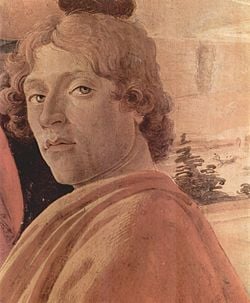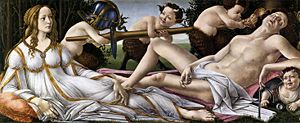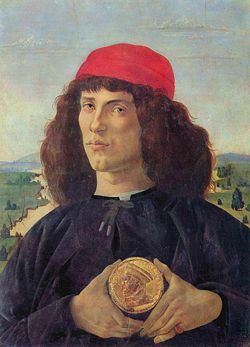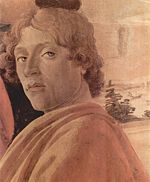Sandro Botticelli
| Sandro Botticelli | |
 Alleged self-portrait of Botticelli, in his Adoration of the Magi. Uffizi, Florence. | |
| Birth name | Alessandro di Mariano Filipepi |
| Born | March 1 1444 or 1445 Florence, Italy |
| Died | May 17 1510 (aged 65) |
| Nationality | Italian |
| Training | Florentine school |
| Movement | Renaissance |
| Famous works | Primavera, 1478 The Birth of Venus, 1486 |
Alessandro di Mariano di Vanni Filipepi, better known as Sandro Botticelli or Il Botticello ("little barrels"; March 1, 1445 ‚Äď May 17, 1510)[1] was an Italian painter of the Florentine school during the Early Renaissance (Quattrocento). Less than a hundred years later, this movement, under the patronage of Lorenzo de' Medici, was characterized by Giorgio Vasari (1511 - 1574) as a "golden age," a thought, suitably enough, he expressed at the head of his Vita of Botticelli. His posthumous reputation suffered until the late nineteenth century; since then his work has been seen to represent the linear grace of Early Renaissance painting, and The Birth of Venus and Primavera rank now among the most familiar masterpieces of Florentine art.
Biography
Youth
Details of Botticelli's life are sparse, but we know that he became an apprentice when he was about 14 years old, which would indicate that he received a fuller education than did other Renaissance artists. Vasari reported that he was initially trained as a goldsmith by his brother Antonio.[2] Probably by 1462 he was apprenticed to Fra Filippo Lippi;[3] many of his early works have been attributed to the elder master, and attributions continue to be uncertain. Influenced also by the monumentality of Masaccio's painting, it was from Lippi that Botticelli learned a more intimate and detailed manner. As has recently been discovered, Botticelli may have traveled to Hungary during this period, participating in the creation of a fresco in Esztergom, ordered in the workshop of Fra Filippo Lippi by Vitéz János, then archbishop of Hungary.
By 1470 Botticelli had his own workshop. Even at this early date his work was characterized by a conception of the figure as if seen in low relief, drawn with clear contours, and minimizing strong contrasts of light and shadow which would indicate fully modeled forms.
Masterworks
The masterworks Primavera (c. 1478) and The Birth of Venus (c. 1485) were both seen by Vasari at the villa of Lorenzo di Pierfrancesco de' Medici at Castello in the mid-sixteenth century, and until recently it was assumed that both works were painted specifically for the villa. More recent scholarship suggests otherwise: the Primavera was painted for Lorenzo's townhouse in Florence, and The Birth of Venus was commissioned by someone else for a different site. By 1499 both had been installed at Castello.[4]
In these works the influence of Gothic realism is tempered by Botticelli's study of the antique. But if the painterly means may be understood, the subjects themselves remain fascinating for their ambiguity. The complex meanings of these paintings continue to receive scholarly attention, mainly focusing on the poetry and philosophy of humanists who were the artist's contemporaries. The works do not illustrate particular texts; rather, each relies upon several texts for its significance. They are characterized by Vasari as exemplifying "grace," and by John Ruskin as possessing linear rhythm.
Maturity and later life
The Adoration of the Magi for Santa Maria Novella (c. 1475-1476, now at the Uffizi) contains the portraits of Cosimo de' Medici ("the finest of all that are now extant for its life and vigour"[5]), his grandson Giuliano de' Medici, and Cosimo's son Giovanni. The quality of the scene was hailed by Vasari as one of Botticelli's pinnacles.
In 1481, Pope Sixtus IV summoned Botticelli and other prominent Florentine and Umbrian artists to fresco the walls of the Sistine Chapel. The iconological program was the supremacy of the Papacy. Sandro's contribution was moderately successful. He returned to Florence, and "being of a sophistical turn of mind, he there wrote a commentary on a portion of Dante and illustrated the Inferno which he printed, spending much time over it, and this abstention from work led to serious disorders in his living." Thus Vasari characterized the first printed Dante (1481) with Botticelli's decorations; he could not imagine that the new art of printing might occupy an artist.
In the mid-1480s Botticelli worked on a major fresco cycle with Perugino, Ghirlandaio, and Filippino Lippi, for Lorenzo the Magnificent's villa near Volterra; in addition he painted many frescoes in Florentine churches.
In 1491 Botticelli served on a committee to decide upon a facade for the Florence Duomo. In 1502 he was accused of sodomy, though charges were later dropped. In 1504 he was a member of the committee appointed to decide where Michelangelo's David would be placed. His later work, especially as seen in a series on the life of Saint Zenobius, witnessed a diminution of scale, expressively distorted figures, and a non-naturalistic use of color reminiscent of the work of Fra Angelico nearly a century earlier.
Religion
In later life, Botticelli was one of Savonarola's followers, though the full extent of Savonarola's influence is uncertain.[6] [7] The story that he burnt his own paintings on pagan themes in the notorious "Bonfire of the Vanities" is not told by Vasari, who asserts that of the sect of Savonarola "he was so ardent a partisan that he was thereby induced to desert his painting, and, having no income to live on, fell into very great distress. For this reason, persisting in his attachment to that party, and becoming a Piagnone[8] he abandoned his work.." Botticelli biographer Ernst Steinman searched for the artist's psychological development through his Madonnas. In the "deepening of insight and expression in the rendering of Mary's physiognomy," Steinman discerns proof of Savonarola's influence over Botticelli. This means that the biographer needed to alter the dates of a number of Madonnas to substantiate his theory; specifically, they are dated ten years later than before. Steinman disagrees with Vasari's assertion that Botticelli produced nothing after coming under the influence of Girolamo Savonarola. Steinman believes the spiritual and emotional Virgins rendered by Sandro follow directly from the teachings of the Dominican monk.
Earlier, Botticelli had painted an Assumption of the Virgin for Matteo Palmieri in a chapel at San Pietro Maggiore in which, it was rumored, both the patron who dictated the iconic scheme and the painter who painted it, were guilty of unidentified heresy, a delicate requirement in such a subject. The heretical notions seem to be gnostic in character:
By the side door of San Piero Maggiore he did a panel for Matteo Palmieri, with a large number of figures representing the Assumption of Our Lady with zones of patriarchs, prophets, apostles, evangelists, martyrs, confessors, doctors, virgins, and the orders of angels, the whole from a design given to him by Matteo, who was a worthy and educated man. He executed this work with the greatest mastery and diligence, introducing the portraits of Matteo and his wife on their knees. But although the great beauty of this work could find no other fault with it, said that Matteo and Sandro were guilty of grave heresy. Whether this be true or not, I cannot say. (Giorgio Vasari)
This is a common misconception based on a mistake by Vasari. The painting referred to here, now in the National Gallery in London, is by the artist Botticini. Vasari confused their similar sounding names.

Legacy
Botticelli was already little employed in 1502; after his death his reputation was eclipsed longer and more thoroughly than that of any other major European artist. His paintings remained in the churches and villas[9] for which they had been created, his frescoes in the Sistine Chapel upstaged by Michelangelo's. The first nineteenth century art historian to have looked with satisfaction at Botticelli's Sistine frescoes was Alexis-François Rio. Through Rio Mrs Jameson and Sir Charles Eastlake were alerted to Botticelli, but, while works by his hand began to appear in German collections, both the Nazarenes and the Pre-Raphaelite Brotherhood ignored him. Walter Pater created a literary picture of Botticelli, who was then taken up by the Aesthetic movement. The first monograph on the artist was published in 1893; then, between 1900 and 1920 more books were written on Botticelli than any other painter.[10]
Recent discovery
Recently, one of four female figures on a fresco in the ruins of the Archbishop's studiolo in the castle of Esztergom, Hungary, was recognized (by Zsuzsanna Wierdl and Maria Prokopp) as possibly the first independent creation by Botticelli. The figures representing four cardinal virtues were ordered from the workshop of Fra Filippo Lippi by Vit√©z J√°nos, then Archbishop of Hungary. The figure attributed to Botticelli‚ÄĒthe temperance‚ÄĒhas many traits of his later works.[11] Some eminent scholars in the field such as Miklos Boskovits and Louis Waldman reject the frescoes' attribution to Botticelli.
List of works
- Madonna and Child with an Angel (1465-1467) -Tempera on panel, 87 x 60 cm, Spedale degli Innocenti, Florence
- Madonna and Child with an Angel (1465-1467) - Tempera on panel, 110 x 70 cm, Musée Fesch, Ajaccio
- Madonna della Loggia (c. 1467) - Tempera on panel, 72 x 50 cm, Uffizi, Florence
- The Virgin and Child with Two Angels and the Young St. John the Baptist (1465-1470) - Tempera on panel, 85 x 62 cm, Galleria dell Accademia, Florence
- The Annunciation (c. 1479) - Tempera on panel, 19 x 30 cm. Hyde Collection, Glens Falls
- The Virgin and Child, St. John and an Angel (c. 1488) - Warsaw National Museum, Poland
- Adoration of the Magi (1465-1467) -Tempera on panel, 50 x 136 cm, National Gallery, London
- Portrait of a Young Man (c. 1469) - Tempera on panel, 51 x 33,7 cm, Palazzo Pitti, Florence
- Madonna in Glory with Seraphim (1469-1470) - Tempera on panel, 120 x 65 cm, Uffizi, Florence
- Madonna of the Sea (1469-1470) - Tempera on wood, 40 x 28 cm, Galleria dell'Accademia, Florence
- Madonna of the Rosegarden (Madonna del Roseto) (1469-1470) - Tempera on panel, 124 x 65 cm, Uffizi, Florence
- Madonna and Child and Two Angels (c. 1468-1470) - Tempera on panel, 100 x 71 cm, Galleria Nazionale di Capodimonte, Naples
- Portrait of Esmeralda Brandini (1470-1475) - Tempera on panel, 65,7 x 41 cm, Victoria and Albert Museum, London
- Fortitude (c. 1470) - Tempera on panel, 167 x 87 cm, Uffizi, Florence
- Madonna and Child with Six Saints (Sant'Ambrogio Altarpiece) (c. 1470) - Tempera on panel, 170 x 194 cm, Uffizi, Florence
- Madonna and Child with an Angel (c. 1470) - Tempera on wood, 84 x 65 cm, Isabella Stewart Gardner Museum, Boston
- The Return of Judith to Bethulia (1470- 1472) - Oil on panel, 31 x 24 cm, Uffizi, Florence
- The Discovery of the Murder of Holofernes (1470-1472) - Tempera on wood, 31 x 25 cm, Uffizi, Florence
- Adoration of the Magi (1465-1467) -Tempera on panel, diameter 131,5 cm, National Gallery, London
- Portrait of a Young Woman (c. 1475) - Tempera on panel, 61 x 40 cm, Palazzo Pitti, Florence
- Adoration of the Magi (1465-1467) -Tempera on panel, 111 x 134 cm, Uffizi, Florence
- St. Sebastian (1474) - Tempera on panel, 195 x 75 cm, Gemäldegalerie, Berlin
- Portrait of a Man with a Medal of Cosimo the Elder (c. 1474-1475) - Tempera on panel, 57,5 x 44 cm, Uffizi, Florence
- Portrait of Giuliano de' Medici (c. 1475) - Tempera on panel, 54 x 36 cm, Accademia Carrara, Bergamo
- Madonna and Child (c. 1475) - Tempera on panel, Art Institute, Chicago
- Catherine of Alexandria, portrait of Caterina Sforza (c. 1475) - Lindenau-Museum, Altenburg
- Nativity (1475-1480) - fresco transferred to canvas, Columbia Museum of Art, Columbia, SC, USA, Gift of Samuel Kress Foundation
- Portrait of Giuliano de' Medici (1476-1477) - Tempera on panel, 75.6 x 36 cm, National Gallery of Art, Washington
- The Birth of Christ, (1476-1477) - Fresco, 200 x 300 cm, Santa Maria Novella, Florence
- Portrait of Giuliano de' Medici (1478) - Panel, 54 x 36 cm, Gemäldegalerie, Berlin
- Madonna and Child with Eight Angels (c. 1478) - Tempera on panel, diameter 135 cm, Gemäldegalerie, Berlin
- St. Augustine (1480) - Fresco, 152 x 112 cm, church of Ognissanti, Florence
- Madonna of the Magnificat (Madonna del Magnificat) (1480-1483) - Tempera on panel, diameter 118 cm, Uffizi, Florence
- Madonna of the Book (Madonna del Libro) (c. 1480-1483) - Tempera on panel, 58 x 39,5 cm, Museo Poldi Pezzoli, Milan
- Portrait of a Young Woman (1480-85) - Tempera on wood, 82 x 54 cm, Stadelsches Kunstinstitut, Frankfurt
- Portrait of a Young Woman (after 1480) - Oil on panel, 47,5 x 35 cm, Gemäldegalerie, Berlin
- Annunciation (1481) - Fresco, 243 x 550 cm, Uffizi, Florence
- St. Sixtus II (1481) - Fresco, 210 x 80 cm, Sistine Chapel, Vatican City
- Adoration of the Magi (1481-1482) - Tempera on panel, 70 x 103 cm, National Gallery of Art, Washington
- Pallas and the Centaur (1482-1483) - Tempera on canvas, 207 x 148 cm, Uffizi, Florence
- Venus and Mars (1483) - Tempera on panel, 69 x 173 cm, National Gallery, London
- Portrait of a Young Man (c. 1483) - Tempera on panel, 37,5 x 28,2 cm, National Gallery, London
- Portrait of a Young Man (c. 1482-1483) - Tempera on panel, 41 x 31 cm, National Gallery of Art, Washington
- The Story of Nastagio degli Onesti (c. 1483) - Tempera on panel, 83 x 138 cm, Museo del Prado, Madrid
- The Virgin and Child Enthroned (Bardi Altarpiece) (1484) - Tempera on panel, 185 x 180 cm, Gemäldegalerie, Berlin
- The Birth of Venus (1484-1486) - Tempera on canvas, 184.5 x 285.5 cm, Uffizi, Florence
- Annunciation (1485) - Tempera and gold on wood, 19,1 x 31,4 cm, Metropolitan Museum of Art, New York
- Madonna Adoring the Child with Five Angels (1485-1490) - Tempera on panel, Baltimore Museum of Art, Baltimore
- Madonna of the Pomegranate (Madonna della Melagrana) (c. 1487) - Tempera on panel, diameter 143,5 cm, Uffizi, Florence
- The Virgin and Child with Four Angels and Six Saints (Pala di San Barnaba) (c. 1487-1488) - Tempera on panel, 268 x 280 cm, Uffizi, Florence
- Vision of St. Augustine (c. 1488) - Tempera on panel, 20 x 38 cm, Uffizi, Florence
- Christ in the Sepulchre (c. 1488) - Tempera on panel, 21 x 41 cm, Uffizi, Florence
- Salome with the Head of St. John the Baptist (c. 1488) - Tempera on panel, 21 x 40,5 cm, Uffizi, Florence
- Extraction of St. Ignatius' Heart (c. 1488) - Tempera on panel, 21 x 40,5 cm, Uffizi, Florence
- Cestello Annunciation (1489-1490) - Tempera on panel, 150 x 156 cm, Uffizi, Florence
- The Virgin Adoring the Child (c. 1490) - Tempera on panel, diameter 59,6 cm, National Gallery of Art, Washington
- Lamentation over the Dead Christ (c. 1490) - Tempera on panel, 140 x 207 cm, Alte Pinakothek, Munich
- Portrait of a Man (c. 1490) - Tempera on canvas transferred from wood, 49 x 35 cm, Private collection
- San Marco Altarpiece (1490-1492) - Tempera on panel, 378 x 258 cm (pala) and 21 x 269 cm (entire predella) Uffizi, Florence
- St. Augustine in His Cell (1490-1494) - Tempera on panel, 41 x 27 cm cm, Uffizi, Florence
- Madonna and Child and the Young St John the Baptist (1490-1495) - Tempera on canvas, 134 x 92 cm, Galleria Palatina (Palazzo Pitti), Florence
- Portrait of Lorenzo di Ser Piero Lorenzi (1490-1495) - Tempera on panel, 50 x 36,5 cm, Philadelphia Museum of Art, Philadelphia
- The Virgin and Child with the Infant St. John the Baptist (1490-1500) - Tempera on wood, diameter 74 cm, S√£o Paulo Art Museum, S√£o Paulo, Brazil
- Holy Trinity (Pala delle Convertite) (1491-1493) - Tempera on panel, 215 x192 cm, Courtauld Institute Galleries, London
- The Virgin and Child with Three Angels (Madonna del Padiglione) (c. 1493) - Tempera on panel, diameter 65 cm, Pinacoteca Ambrosiana, Milan
- Calumny of Apelles (1494-1495) - Tempera on panel, 62 x 91 cm, Uffizi, Florence
- Lamentation over the Dead Christ with Saints (c. 1495) - Tempera on panel, 107 x 71 cm, Museo Poldi Pezzoli, Milan
- Last Communion of St. Jerome (c. 1495) - Tempera on panel, 34,5 x 25,4 cm, Metropolitan Museum of Art, New York
- Portrait of Dante (c. 1495) - Tempera on canvas, 54,7 x 47,5 cm, Private collection
- The Story of Virginia (1496-1504) - Tempera on panel, 85 x 165 cm, Accademia Carrara, Bergamo
- The Story of Lucretia (1496-1504) - Tempera on panel, 83,5 x 180 cm, Isabella Stewart Gardner Museum, Boston
- Crucifixion (c. 1497) - Tempera on canvas, 73,5 x 50,8 cm, Fogg Art Museum, Harvard University, Cambridge
- Christ Crowned with Thorns (c. 1500) - Tempera on panel, 47.6 x 32.3 cm, Accademia Carrara, Bergamo, Italy
- Transfiguration, St Jerome, St Augustine (c. 1500) - Tempera on panel, 27,5 x 35,5 cm, Galleria Pallavicini, Rome
- Judith Leaving the Tent of Holofernes (1495-1500) - Tempera on panel, 36,5 x 20 cm, Rijksmuseum, Amsterdam
- Agony in the Garden (c. 1500) - Tempera on panel, 53 x 35 cm, Capilla Real, Granada
- The Mystical Nativity (c. 1500) - Tempera on canvas, 108.5 x 75 cm, National Gallery, London
- Baptism of St. Zenobius and His Appointment as Bishop (1500-1505) - Tempera on panel, 66.5 x 149.5 cm, National Gallery, London
- Three Miracles of St. Zenobius (1500-1505) - Tempera on panel, 65 x 139.5 cm, Metropolitan Museum of Art, New York
- Three Miracles of St. Zenobius (1500-1505) - Tempera on panel, 67 x 150,5 cm, Metropolitan Museum of Art, New York
- Last Miracle and the Death of St. Zenobius (1500-1505) - Tempera on panel, 66 x 182 cm, Gemäldegalerie, Dresden
See also
Notes
- ‚ÜĎ Soylent Communications. Sandro Botticelli NNDB.com. Retrieved May 29, 2008.
- ‚ÜĎ According to Vasari, he was still in school in February of 1458; an able pupil, he easily grew restless, and was initially apprenticed as a goldsmith. R. Lightbown. Sandro Botticelli: Life and Work. (New York: Abbeville Press, 1989), 19.
- ‚ÜĎ Lightbown, 20.
- ‚ÜĎ Webster Smith, "On the Original Location of the Primavera." in Peter Burke. The Italian Renaissance: Culture and Society in Italy. (Polity Press, 1999)
- ‚ÜĎ Giorgio Vasari. Lives, translated by Julia Conway Bondanella and Peter Bondanella. (Oxford World's Classics) (Oxford Univ. Press USA, 1998).
- ‚ÜĎ Lightbown, 238-253.
- ‚ÜĎ Mimi Murphy in Florence, Mar. 21, 2004, Return of a Forgotten Master, TIME. Retrieved May 29, 2008.
- ‚ÜĎ A "Weeper" or "Mourner," as the repentant followers of Savonarola were called. (Vasari text on-line).
- ‚ÜĎ Primavera and The Birth of Venus remained in the Grand Ducal Medici villa of Castello until 1815. (Levey 1960 :292
- ‚ÜĎ This section is based on Michael Levey, "Botticelli and Nineteenth-Century England" Journal of the Warburg and Courtauld Institutes 23 (3/4) (July 1960): 291-306.
- ‚ÜĎ Associated Press. Possible Botticelli fresco found in Hungary, "Piece depicts four female figures representing the four cardinal virtues" MSNBC, June 8, 2007. Retrieved May 29, 2008.
ReferencesISBN links support NWE through referral fees
- Da Vinci Declassified. 2006 TLC documentary
- Knackfuss H. Monographs On Artists, VI. Botticelli by Ernst Steinman, Translated by Campbell Dodgson. New York: Lemcke & Huachner, 1901, 112. OCLC 8664804
- Lightbown, R. Sandro Botticelli: Life and Work. New York: Abbeville Press, 1989. ISBN 9780896599314
- The New Encyclopaedia Britannica, Macropaedia, Volume 2, 1991, 413-414. Chicago: Encyclopaedia Britannica, 1998. ISBN 9780852296639
- Smith, Webster. "On the Original Location of the Primavera." (original 1975) in Peter Burke, The Italian Renaissance: Culture and Society in Italy. Polity Press, 1999. ISBN 0745621384.
- Swinglehurst, Edmund. Life of Botticelli. Great Britain: Parragon, 1994. BR783. ISBN 9781858136011
- Ullmann, H., Sandro Botticelli. M√ľnchen: Verlagsanstalt f√ľr Kunst und Wissenschaft, [1893]. OCLC 66076745 reprint ed. 2008. ISBN 0841600759
- Vasari, Giorgio. The Lives of the Artists, translated by Julia Conway Bondanella and Peter Bondanella. (Oxford World's Classics) Oxford Univ. Press USA, 1998. ISBN 019283410X
- Vasari, Georgio. [1], in English. Medieval Sourcebook. Fordham University. Retrieved May 29, 2008.
- Yashiro, Yukio, Sandro Botticelli and the Florentine Renaissance. Boston: Hale, Cushman & Flint; London: The Medici society, 1929. OCLC 2982114
External links
All links retrieved December 22, 2022.
| |||||||
Credits
New World Encyclopedia writers and editors rewrote and completed the Wikipedia article in accordance with New World Encyclopedia standards. This article abides by terms of the Creative Commons CC-by-sa 3.0 License (CC-by-sa), which may be used and disseminated with proper attribution. Credit is due under the terms of this license that can reference both the New World Encyclopedia contributors and the selfless volunteer contributors of the Wikimedia Foundation. To cite this article click here for a list of acceptable citing formats.The history of earlier contributions by wikipedians is accessible to researchers here:
The history of this article since it was imported to New World Encyclopedia:
Note: Some restrictions may apply to use of individual images which are separately licensed.


